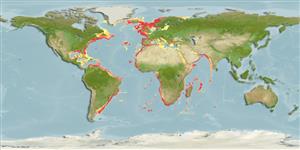>
Perciformes/Scorpaenoidei (Scorpionfishes) >
Sebastidae (Rockfishes, rockcods and thornyheads) > Sebastinae
Etymology: Helicolenus: Greek, helike, -es = spiral + Greek, lenos, -ou = cavity (Ref. 45335).
Environment: milieu / climate zone / depth range / distribution range
Ecologia
marinhas batidemersal; intervalo de profundidade 50 - 1100 m (Ref. 41452), usually 150 - 600 m (Ref. 84778). Deep-water; 70°N - 46°S
Western Atlantic: Nova Scotia, Canada to Venezuela. Eastern Atlantic: Iceland (Ref. 12462) and Norway to the Mediterranean and the Gulf of Guinea, including Madeira, the Azores, and the Canary Islands; also Walvis Bay, Namibia to Natal, South Africa (Ref. 4313).
Comprimento de primeira maturação / Tamanho / Peso / Idade
Maturity: Lm 32.0 range ? - ? cm
Max length : 50.0 cm TL macho/indeterminado; (Ref. 89108); common length : 25.0 cm TL macho/indeterminado; (Ref. 4510); peso máx. publicado: 1.6 kg (Ref. 40637); idade máx. registrada: 43 anos (Ref. 41452)
Espinhos dorsais (total): 12; Raios dorsais (total): 12-13; Espinhos anais 3; Raios anais : 5. Pinkish with faint dusky bars; Y-shaped dark bar between soft dorsal and anal fins (Ref. 4313).
Adults are found in soft bottom areas of the continental shelf and upper slope. They feed on both benthic and pelagic organisms (crustaceans, fishes, cephalopods, and echinoderms) (Ref. 4570). The reproductive mode is a zygoparous form of oviparity, intermediate between oviparity and viviparity (Ref. 36265, 79712). Larvae and juveniles are pelagic (Ref. 4570). Anterolateral glandular grooves with venom gland (Ref. 57406). Sold fresh (Ref. 27121).
The reproductive mode is a zygoparous form of oviparity, intermediate between oviparity and viviparity (Ref. 36265, 79712). Eggs covered with gelatinous material are fertilised in the ovary. Eggs are released into the seabed at various stages of development and larvae assumes a planktonic existence once the gelatinous covering dissolves (Ref. 31150).
Eschmeyer, W.N. and L.J. Dempster, 1990. Scorpaenidae. p. 665-679. In J.C. Quero, J.C. Hureau, C. Karrer, A. Post and L. Saldanha (eds.) Check-list of the fishes of the eastern tropical Atlantic (CLOFETA). JNICT, Lisbon; SEI, Paris; and UNESCO, Paris. Vol. 2. (Ref. 4510)
Status na Lista Vermelha da UICN (Ref. 130435)
Uso pelos humanos
Pescarias: espécies comerciais
Ferramentas
Relatórios especiais
Baixar XML
Fontes da internet
Estimates based on models
Preferred temperature (Ref.
123201): 4 - 18.1, mean 10.6 °C (based on 1236 cells).
Índice de diversidade filogenética (Ref.
82804): PD
50 = 0.5020 [Uniqueness, from 0.5 = low to 2.0 = high].
Bayesian length-weight: a=0.01047 (0.00911 - 0.01203), b=3.08 (3.04 - 3.12), in cm total length, based on LWR estimates for this species (Ref.
93245).
Nível Trófico (Ref.
69278): 3.5 ±0.0 se; based on diet studies.
Generation time: 9.6 (7.0 - 14.1) years. Estimated as median ln(3)/K based on 18
growth studies.
Resiliência (Ref.
120179): Baixo, tempo mínimo de duplicação da população 4,5 - 14 anos (K=0.06-0.2; tm=13-16; tmax=43).
Prior r = 0.40, 95% CL = 0.27 - 0.61, Based on 1 stock assessment.
Fishing Vulnerability (Ref.
59153): High to very high vulnerability (68 of 100).
Nutrients (Ref.
124155): Calcium = 19.7 [7.7, 55.8] mg/100g; Iron = 0.376 [0.168, 0.881] mg/100g; Protein = 16.7 [14.9, 18.7] %; Omega3 = 0.561 [0.214, 1.568] g/100g; Selenium = 21.7 [8.2, 65.8] μg/100g; VitaminA = 14.6 [3.1, 72.9] μg/100g; Zinc = 0.495 [0.271, 0.819] mg/100g (wet weight); based on
nutrient studies.
